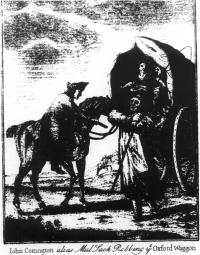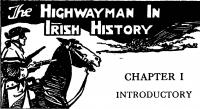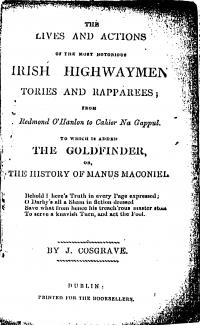Highwaymen, Tories and Rapparees by Niall 6 Ciosain
Published in 18th-19th Century Social Perspectives, 18th–19th - Century History, Features, Issue 3 (Autumn 1993), Volume 1
From The Newgate Calendar
(reprinted 1926)
There was a time when Irish boys were free to choose their own school readers … being sturdy lads, born into a heritage of suffering and persecution, the spirit of resistance burning in their veins, it is not surprising that the reading book they liked best was a cheap little work containing an account of the daring deeds of famous Irish outlaws, rapparees and highwaymen.
Introduction to ‘Highwaymen in Irish History’ (Our Boys 7937)
Who were these outlaws and what was this popular book? Criminal biography was one of the standard genres of popular literature in eighteenthand nineteenth-century Europe and a frequent item among the small books sold by travelling pedlars and shops in rural areas. Our Boys was referring to the main Irish example of the genre, The Lives and Actions of the Most Notorious Irish Highwaymen, Tories and Rapparees. The book was first printed in the mid-eighteenth century and had very frequent reprints at a low price; in the early nineteenth-century it could be bought for threepence at a time when a newspaper cost four or five pence. Although the criminals described in the book were all based on real figures, mostly from the seventeenth and early eighteenth centuries, their stories are largely fictionalised. They are presented as ‘noble robbers’ of genteel extraction, robbing the rich to give to the poor, and supported by the people. This sort of figure is common in European folklore. As a literary figure, however, the highwayman or robber has other textual origins whose examination will explain the particular form taken by the figures in Irish Highwaymen.

from the book version of Our Boys (1932).
Criminal countercultures
Loveable villains
If the classification literature presents a static picture of crime, the second source supplies a narrative dimension focussing on an individual robber – the picaresque novel, also a genre of sixteenth- and seventeenth- century origin. It follows the adventures of a rogue, presented sympathetically as a loveable villain, through an episodic series of tricks and frauds perpetrated on others. The keyword of the picaresque was ‘rogue’ – texts frequently had titles like The English Rogue – and the connection was clear to readers of Irish Highwaymen which was commonly known as ‘Irish Rogues’.
I Last speeches I
The third sOurce come from the actual historical figures to whose names the stories are attached – the practice of printing the ‘last speeches’ of condemned criminals before death, detailing their crimes and professing repentance. These texts, usually single sheets, were generally sold round the scaffold to provide a written counterpart to the public ritual of seventeenth and eighteenthcentury execution. In early eighteenth-century England, the three strands were combined to produce large collections of criminal lives, such as The Complete History of the Lives and Robberies of the most notorious Highwaymen by Alexander Smith, first published in London in 1714. This and similar books were best-sellers in their day. Irish Highwaymen was clearly intended to be their Irish equivalent, even taking some of its characters from Smith’s book. The characters in Irish Highwaymen, therefore, although based on actual historical figures, are presented in a highly stylised way: some of the crimes are told factually, some roguish stories are added, in which the robber tricks his victims, and many of the figures have followers and power structures of their own. This genealogy explains how the texts took the shape they did, and it suggests their possible attraction for the better-off reader, keen to understand crime by classifying it and to become aware of robbers’ methods. It does not entirely explain the continuing appeal of the book to less privileged readers. It was probably due to the more favourable view of the noble robber in folklore, which would have influenced the style of reading amongst a popular audience, picking out, for example, the more sympathetic elements deriving from the picaresque
 Traditional morality in conflict with the state
Traditional morality in conflict with the state
The noble robber had a particular resonance in the period in which Irish Highwaymen was read. One of the main targets of its characters is authority and the state, and favourite victims are soldiers and tax collectors. The eighteenth and nineteenth were the centuries in which the ordinary reader came into continuous contact with state agencies for the first time, whether paying tax or appearing in court. The criminal biography frequently presents key moments in which a traditional morality comes into conflict with state law and order agencies. Take for example the beginning of the life of Paul Liddy, ‘a gentleman robber’:
Paul Liddy was born in Munster, of very reputable parents, who had him educated after a genteel manner, by the best masters in the country … But before he had well arrived at man’s estate, it happened very unluckily for him, that a kinsman of his was taken by the sheriff of the county, upon an execution for a debt … Paul and his brother having notice thereof…came with assistance to the rescue of his relation, whom they carried away from the bailiffs by force, but in the conflict one of the sheriff’s servants happened to be killed … whereupon warrants upon warrants were issued out after the rescuers, and great rewards offered for taking the leaders.
Moral legitimacy derived from dispossessed aristocracy
In the Irish case, the implications of the nobility of the robber are striking. Some of the characters in Irish Highwaymen are connected in various ways to the old Catholic aristocracy, which was broken in the seventeenth century. O’Hanlon is described as coming from one of the ‘Irish families who had a hand in the wars of Ireland, were dispossessed, and their lands forfeited’. The moral legitimacy of the bandit hero in Ireland, therefore, derives partly or mainly from genealogical continuity with a dispossessed aristocracy. This would have been clear to readers,not only from the lives themselves, but also from the title of the book. ‘Tories’ were ‘T6raithe’, literally ‘wanted’ outlaws in the period following the wars of the 1640s and 1689-91, dispossessed landowners and evicted tenants remaining in their areas as bandits.
Influence on popular
political thought Given this powerful political undercurrent in Irish Highwaymen, the text is of importance within the history of popular political thought in Ireland. By the 1790s the feeling of dispossession, initially aristocratic, became more generalised among sections of the rural population, sometimes among all those who shared the surname of the original landowner. When or how this generalisation occurred is not clear; Gaelic poetry was probably one vehicle of the ideology, criminal biography in English another. In the nineteenth century, within popular Catholic nationalist politics,there was clearly a use for figures who embodied an anti-state and antilandlord ideology, and the highwaymen were reconstituted as protonationalists, fighting the British state and landlordism. This necessitated a semantic shift – the original title mentions Highwaymen, Tories and Rapparees, but the word ‘Tory’ was clearly inappropriate and even awkward by the nineteenth century since it had taken on its present meaning within British politics. There was therefore a shift towards replacing it with ‘Rapparees’, and these became a stock figure of later nationalist poetry and novels. Charles Gavan Duffy, the Young Irelander, provides an early case in a ballad called The Rapparees:
Now Sassenach and Cromweller, take heed of what I say, Keep down your black and angry looks that scorn us night and day; For there’s a just and wrathful Judge that every action sees, And He’ll make strong, to right our wrong, the faithful Rapparees.
One could multiply examples from the later nineteenth and early twentieth centuries, and it was within this context that Our Boys presented its highwaymen as nationalist figures. By this time, the highwaymen had been through a number of literary transformations and bore little resemblance to the historical figures on which they were ostensibly based.
Niall 6 Ciosain lectures in history at University College Galway.
Further reading:
E.G. Hobsbawn, Bandits (Harmondsworth
1969).
L.B. Falaler, Turned to Account: the
forms and functions of criminal biography
in eighteenth-century England
(Cambridge 1987).
R. Chartier, ‘The literature of roguery
in the Bibliotheque Bleue’ in R.
Chartier (ed.), The cultural uses of print
in early modern France (Princeton
1987).
















